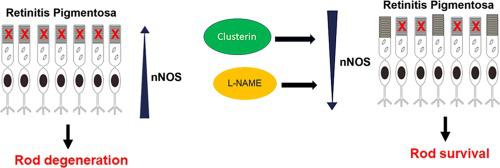Brain Research ( IF 2.7 ) Pub Date : 2021-07-06 , DOI: 10.1016/j.brainres.2021.147575 Andrew Vargas 1 , Kyra L Yamamoto 1 , Cheryl Mae Craft 2 , Eun-Jin Lee 3

|
Environmental changes in the retina, including oxidative stress-induced cell death, influence photoreceptor degeneration in Retinitis Pigmentosa (RP). Previously, we tested and discovered that a cytoprotective chaperone protein, clusterin, produced robust preservation of rod photoreceptors of a rat autosomal dominant rhodopsin transgenic model of RP, S334ter-line3. To investigate the biochemical and molecular cytoprotective pathways of clusterin, we examined and compared a known source of cone cell death, nitric oxide (NO), observing nNOS expression using antibody against nNOS in RP retinas with intravitreal injections of saline, clusterin (10 μg/ml), or a non-isoform-selective NOS inhibitor (25 mM), L-NAME, or with an intraperitoneal injection (IP) of L-NAME (100 mg/kg). Rhodopsin-immunoreactive rod photoreceptor cells and nNOS-immunoreactive cells were quantified with immunohistochemistry in the presence or absence of L-NAME or clusterin, and the total nNOS retinal expression was determined by immunoblot analysis. In this study, the level of nNOS expression was significantly up-regulated postnatally (P) at P15 (P < 0.05), P30 (P < 0.001) and P60 (P < 0.0001) in RP retinas compared to normal controls. Clusterin treatment suppressed the up-regulated nNOS expression in RP retinas (P < 0.0001) and was enhanced in Type II amacrine cells. Additionally, IP injection of L-NAME at P15 prolonged rod survival in the later stage of RP retinas (P < 0.001). Conversely, rod survival in L-NAME–treated RP retinas was not equivalent to the rod survival number seen in clusterin-treated retinas, which suggests induction of nNOS expression in RP retinas and its reduction by clusterin is only partly responsible for the rescue observed through the reduction of nNOS expression in S334ter-line3 rat retinas.
中文翻译:

Clusterin 通过抑制视紫红质 S334ter-line3 视网膜色素变性模型中神经元一氧化氮合酶的表达来提高细胞存活率
视网膜的环境变化,包括氧化应激诱导的细胞死亡,会影响色素性视网膜炎 (RP) 中的光感受器退化。以前,我们测试并发现细胞保护性伴侣蛋白凝聚素对大鼠常染色体显性视紫红质转基因模型 S334ter-line3 的视杆细胞产生了强大的保护作用。为了研究凝聚素的生化和分子细胞保护途径,我们检查并比较了已知的锥细胞死亡来源一氧化氮 (NO),在玻璃体内注射盐水凝聚素 (10 μg/ ml),或非同种型选择性 NOS 抑制剂 (25 mM)、L-NAME,或腹腔内注射 (IP) L-NAME (100 mg/kg)。在存在或不存在 L-NAME 或凝聚素的情况下,用免疫组织化学对视紫红质免疫反应性杆状感光细胞和 nNOS 免疫反应性细胞进行量化,并通过免疫印迹分析确定总 nNOS 视网膜表达。在本研究中,与正常对照组相比,RP 视网膜中 nNOS 表达水平在出生后 (P) 显着上调 (P),P15 (P < 0.05)、P30 (P < 0.001) 和 P60 (P < 0.0001)。Clusterin 处理抑制了 RP 视网膜中上调的 nNOS 表达(P < 0.0001),并在 II 型无长突细胞中增强。此外,在 P15 IP 注射 L-NAME 可延长 RP 视网膜后期视杆细胞的存活时间(P < 0.001)。相反,L-NAME 处理的 RP 视网膜中的视杆存活率不等于在凝聚素处理的视网膜中看到的视杆存活数,











































 京公网安备 11010802027423号
京公网安备 11010802027423号